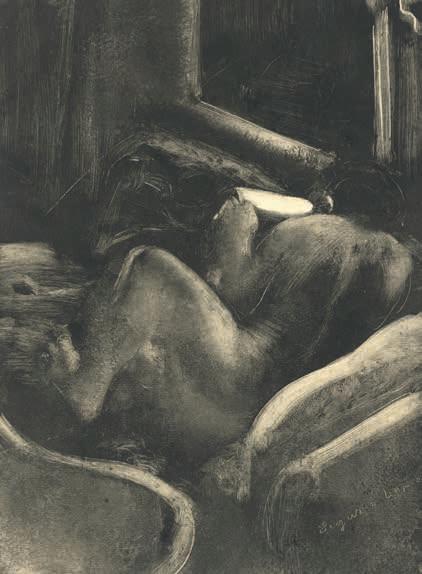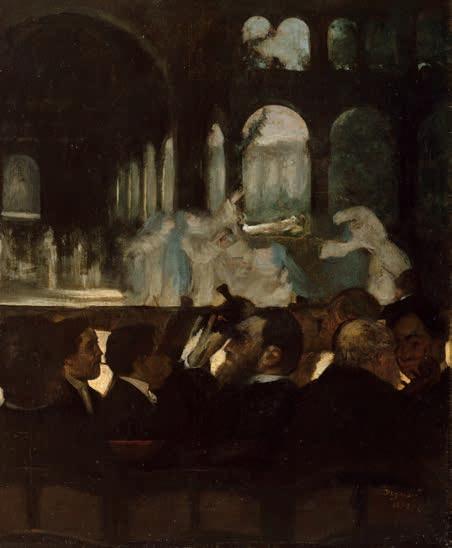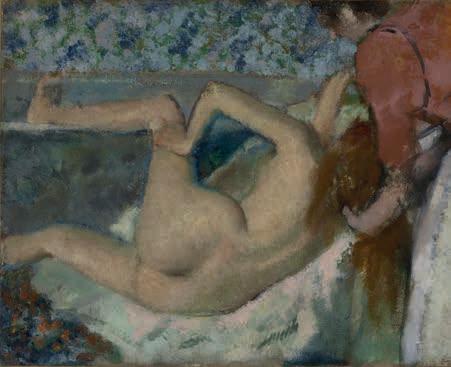





by
ANNA GRUETZNER ROBINSp. 7
Memories of Degas
GEORGE MOOREp. 25
Memories of Degas
WALTER SICKERTp. 77
List of illustrations
p. 110
Opposite: Woman Reading, ‘Liseuse’, c. 1885

by
ANNA GRUETZNER ROBINSp. 7
Memories of Degas
GEORGE MOOREp. 25
Memories of Degas
WALTER SICKERTp. 77
List of illustrations
p. 110
Opposite: Woman Reading, ‘Liseuse’, c. 1885
Degas could have easily competed with either artist for celebrity status in Britain, a country that craved news of its artists in the way it follows the lives of actors today. But as Moore and Sickert realized, making and collecting art came first for Degas, not the props of style and luxury that were necessary to many late nineteenth-century artists. Moore’s descriptions of the ‘perennial gloom and dust’, the canvases ‘pile[d] up in formidable barricades’ and the ‘decaying sculpture’ in Degas’s rue Fontaine St Georges studio, and Sickert’s memories of the clutter in Degas’s later studio, present a fascinating picture of the live-work spaces that he created in Montmartre. Degas does not fit the image of the bohemian artist. He did not womanise, live his life to excess or starve in a garret; but he was a modern artist who took risks. As Moore realised, Degas’s cynical view of fame, his disdain for the pictures of successful but more conventional painters like Gérôme and Bastien-Lepage, Roll and Besnard, and his disregard for bourgeois necessities are symptomatic of this risk-taking and some of the identifying characteristics of the nineteenth-century modern artist.
When Moore published his ‘Memories of Degas’ in the Burlington Magazine he had not spoken to Degas for nearly thirty years, so it is hardly surprising that he decided to republish the important early article ‘Degas: The Painter of Modern Life’ of 1890. Moore

Édouard Manet, George Moore (‘Au café’), 1878 or 1879
remembered meeting Degas around 1876 when he was a regular visitor to the Café de la Nouvelle Athènes, a haunt of the Impressionist painters and naturalist writers during the 1870s. Moore was privileged to gain firsthand contact with them, which he maintained after his return to London in 1879, making frequent trips to Paris during the following decade. His article on Degas is based on a recent visit to Degas’s studio, possibly in 1888 when Moore found Degas reading his novel Confessions
anna gruetzner robins
of a Young Man, which was serialized in French that year and which contains a portrait of Degas.
When explaining the essential character of Degas’s modernity, Moore sees Degas through the eyes of a novelist. Tellingly he mentions a recent drawing by Ingres that Degas recently acquired for his collection before explaining the two artists’ similar interest in the expressive function of line in their drawing, as well as pointing out their significant differences. Because Degas represented dancers rather than goddesses from the Antique, he could be placed together with the best realist and naturalist French writers. The fragments of dancers that Degas depicted from unusual viewpoints and at odd angles were devised to give the illusion of movement. ‘Dancers fly out of the picture, a single leg crosses the foreground’ is one of Moore’s pithy descriptions, but it matches the impressionistic perception of fleeting movement in Degas’s dance pictures. As Moore said, Degas ‘has done so many dancers’ and ‘so often repeated himself ’, but he had an uncanny way of identifying the distinctive characteristics of a picture like ‘the great space of bare floor... balanced by the watering-pot’ in Dancers Practising at the Barre, 1877 (Metropolitan Museum of Art, New York, reproduced p. 54), where that bare empty space is a soothing antidote to the tortuous poses of the dancers at the barre. Together with
this innovative approach of figure composition, Degas experimented with new techniques, including combinations of media, using pastel and distemper together for example. Moore was not at his best when describing these innovations, but by pointing out the ‘new means’ of Degas’s ‘novel and original manner’, he was drawing attention to an essential aspect of the modernity of Degas’s picture-making.
Moore was adept at recycling his writing on Impressionism, of using a review as the basis of a fictional narrative, of describing a picture in a novel, of expanding on his first viewing of it in his reminiscences, so that his writings create overlapping impressions of a single picture. Moore makes his readers believe that he is seeing the pastel nudes of ‘three coarse women, middle-aged and deformed by toil’ for the first time, but in fact, he had written about all three in a review of the 1886 Impressionist exhibition, and he also included a version of the review in a description of a visit to an Impressionist exhibition in Confessions of a Young Man where he telescopes several exhibitions into one.
Of all the Impressionist artists, Degas was most popular with British collectors, and he was the first to receive the institutional support of the Victoria and
Overleaf: Before the Race, c. 1885


anna gruetzner robins
Albert Museum and the National Gallery. Moore’s 1890 article was illustrated with Degas pictures from the collections of Constantine Ionides and Walter Sickert, who had used his wife’s money to buy three of Degas’s works, and his later reminiscences in the Burlington Magazine had illustrations from the collection of Sir William Eden, who was encouraged to collect by Moore and Sickert.
It is tempting to wonder whether Moore would have had a larger hand in introducing Degas to the British if he had not indiscreetly referred to the disastrous financial affairs of the Degas family in the 1890 article, as a result of which a furious Degas never spoke to him again. His ‘Memories of Degas’ were very old memories indeed. It was different for Sickert, who was twenty-three when he first met Degas in 1883, and around fifty-three, the age that Degas was when they first met, when he saw Degas for the last time just before the Great War. His tribute, written shortly after Degas’s death, is a time capsule of a thirty-year friendship played out during a memorable summer in Dieppe in 1885, in the exhibitions they saw together in Paris, and in the various studios that Degas inhabited until he finally settled at 37 rue Victor Massé in 1890, where he took over two more floors in 1897 and lived until 1912. Passing its demolished walls, Sickert in a poignant moment recalls that Degas’s live-work space

Rue Victor Massé, c. 1904. Degas’ block is on the right, opposite the Bal Tabarin on rue Pigalle
– with the first floor for living, the middle one for his large collection, and the third as his studio – had been the ‘lighthouse of my existence.’
When Sickert first knocked on his door in 1883 Degas was a noted recluse, but Sickert brushed aside his excuse of sickness, always the explanation of a depressive, and persuaded Degas to show him all the work that he could. Sickert’s reminiscences are filled with memories of his viewings of Degas’s work and collection, such as his 1883 sighting of the wax sculptures Degas kept under glass
anna gruetzner robins
(on Sickert’s last visit Degas would take one of these statuettes and turn it in front of a candle to show the changing movement of its form in shadow) and the recent pastel bathers that Degas showed him and his first wife Ellen Cobden when they visited him in Paris in 1885. Degas told them that ‘Je veux regarder par le trou de la serrure’ (I want to look through a keyhole) as a way of explaining the close-up, cut-off viewpoint that characterise his representations of these female bathers who are seemingly unaware of the viewer. Some of these pastels were the cause of critical scandal when Degas exhibited them at the last Impressionist exhibition the following year. When he asked Sickert what would happen if he sent them to the Royal Academy (‘Qu’est qu’ils feraient à l’Académie Royale si je leur envoyais ça?’), Sickert told him that he would be shown the door. It still seems remarkable that Degas’s pastels might have graced the walls of the Royal Academy in 1886.
Degas made several trips to England, including one wto Brighton to visit Henry Hill, an important early collector who acquired five Degas ballet pictures in the 1870s, one of them The Rehearsal of the Ballet on Stage, c. 1873-74 (The Metropolitan Museum of Art, reproduced pp. 18-19), which Sickert later bought for his own collection. (At one point, Hill apparently thought of leaving them to the Brighton Art Gallery. What a

treasure trove that would have been!) Degas’s comments about English artists speak of a keen interest in what took place on the other side of the Channel. Degas might have mocked the habits of the Pre-Raphaelite John Everett Millais, who dressed as an English gentleman, in stark contrast to Degas’s shabby bohemian style, but this did not stop Degas from admiring his pictures, including Millais’s Eve of St Agnes, 1862-63 (Royal Collection), at the 1867 Paris Universal Exhibition. When he visited another Universal Exhibition in Sickert’s company in 1889, Degas and Sickert in Dieppe, 1885
Overleaf: The Rehearsal of the Ballet on Stage, c. 1873-74


anna gruetzner robins
English pictures like the little-known James Charles’s Christening Sunday (Manchester City Art Gallery) or William Orchardson’s Master Baby, 1886 (National Gallery of Scotland), with suppressed or unresolved narrative, impressed him, possibly because many of his figure compositions, including the early ballet pictures, resonate with the same ambiguity of meaning.
All of Degas’s encounters with Sickert took place in France, and Sickert’s tribute to him is peppered with more than its usual share of French, with a bit of German and Italian thrown in to show off his cosmopolitanism. Sickert spoke French fluently, which made it easy for him to share what he called Degas’s ‘rollicking and somewhat bear-like sense of fun’ when Degas fired off one of his customary bon-mots. Who could forget his comment to Sickert about the Waterlilies by his Impressionist colleague Monet: ‘I don’t feel the need to swoon in front of a pool’ (Je n’éprouve pas le besoin de perdre connaissance devant un étang)? Or his remark when Whistler was expected in Dieppe where Degas and Sickert were staying in 1885: ‘Playing the butterfly must be very exhausting. I prefer the part of the old ox, what?’ (‘Le rôle de papillon doit être bien fatiguant, allez! J’aime mieux, moi, être le vieux boeuf, quoi?’). There was a tug of war over Sickert that summer when Whistler’s favourite pupil and follower fell under Degas’s spell, and was rewarded accordingly
 After the Bath, c. 1895
After the Bath, c. 1895


when Degas included him in an extraordinary group pastel portrait Six Friends at Dieppe, 1885 (Museum of Art, Rhode Island School of Art, reproduced p. 84). The pastel was drawn from life in the Dieppe studio of Jacques-Emile Blanche and the occasion was the first of many opportunities for Sickert to observe Degas at work, and to see what effort went into giving the impression that the complex grouping of figures had happened by accident. As Degas told Sickert: ‘You create the effect of truth by means of falsehood.’ (On donne l’idée du vrai avec le faux.’) The ‘false means’ involved piecing, or what Sickert called joining, ‘together firmly an immense quantity of first rate material’, meaning the figure studies that Degas drew and redrew with such extraordinary aplomb before arranging and rearranging them on paper and canvas in compositional arrangements that have a striking casual immediacy about them.
That Moore and Sickert wrote such interesting and interconnecting first-hand accounts of Degas, that continue to be worthwhile introductions to his art, is a lasting testimony to their friendship with him.
Opposite: Bather Drying Herself, c. 1892